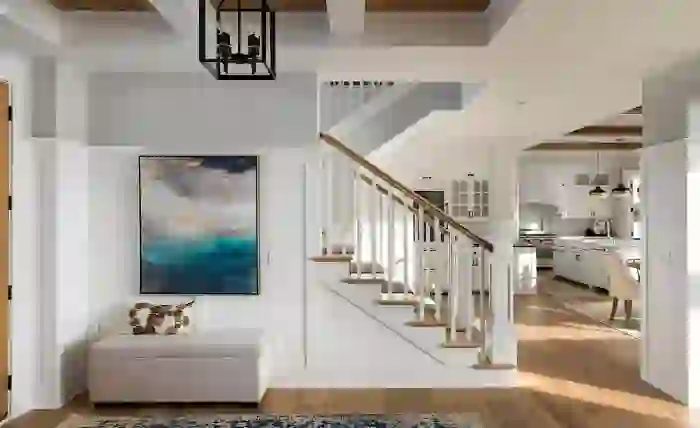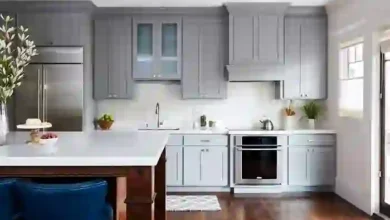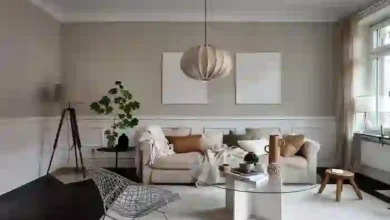Exploring Wainscoting Styles: Enhancing Your Home’s Elegance

Wainscoting is a timeless interior design feature that adds sophistication and character to any home. Whether you’re looking to infuse a touch of traditional charm or modern elegance into your living spaces, wainscoting styles offer a world of possibilities. In this comprehensive guide, we’ll delve into the fascinating realm of wainscoting, exploring different styles, installation techniques, and creative ideas to transform your home.
What is Wainscoting?
Wainscoting, a term originating from the Middle Low German word “wagenschot,” which means “wall board,” is a decorative wall covering that extends partially up a wall’s surface. It typically consists of panels or boards, molding, and trim. Wainscoting serves both aesthetic and practical purposes, as it can enhance a room’s visual appeal while also protecting walls from wear and tear.
A Brief History of Wainscoting
Wainscoting has a rich history dating back to medieval times. Initially, it was used to insulate and protect the lower parts of walls from moisture and dirt. Over the centuries, it evolved into a decorative element associated with luxury and craftsmanship. In grand estates and historic homes, wainscoting was a symbol of affluence and taste.
Wainscoting vs. Beadboard: Understanding the Difference
While the terms “wainscoting” and “beadboard” are sometimes used interchangeably, they refer to distinct wall treatments. Wainscoting typically includes panels or boards that cover a portion of the wall, often accompanied by decorative molding and trim. Beadboard, on the other hand, is a type of wainscoting that consists of narrow, vertical planks with a distinctive groove or bead running down the center. Understanding this difference is crucial when selecting the right style for your home.
Read more about Modern Wainscoting: Elevate Your Home’s Aesthetics with Timeless Elegance
Popular Wainscoting Styles
When it comes to wainscoting, there’s no shortage of styles to choose from. Each style brings its own unique character to your interior spaces. Let’s explore some of the most popular wainscoting styles:
Classic Raised Panel Wainscoting
Classic raised panel wainscoting is a timeless choice known for its elegance and sophistication. It features flat panels with raised, decorative frames. This style works well in formal dining rooms, entryways, and traditional living spaces, adding a touch of refinement and depth to the walls.
Shaker Style Wainscoting
Shaker style wainscoting is characterized by its simplicity and clean lines. Inspired by the Shaker furniture design, this style uses flat, recessed panels and straightforward trim. It’s a versatile choice that can suit both modern and traditional interiors.
Board and Batten Wainscoting
Board and batten wainscoting is a rustic and charming option. It involves attaching vertical boards to the wall and covering the seams with narrower battens. This style works well in farmhouse-style kitchens, mudrooms, and cozy bedrooms, adding a cozy and inviting atmosphere.
Beadboard Wainscoting
Beadboard wainscoting is a classic choice that brings a cottage-like charm to any room. The distinctive beadboard pattern consists of narrow vertical planks with a decorative bead running along the center. It’s a popular choice for bathrooms, kitchens, and coastal-themed spaces.
Picture Frame Wainscoting
Picture frame wainscoting is an artistic and eye-catching style that creates the illusion of framed pictures on the wall. It involves adding rectangular frames within the wainscoting design, providing a dynamic and visually appealing look. This style is perfect for enhancing the aesthetics of a dining room or home office.
Modern Flat Panel Wainscoting
For those who prefer a sleek and contemporary look, modern flat panel wainscoting is an excellent choice. This style features flat panels without raised detailing, offering a clean and minimalistic appearance. It’s a versatile option that can complement modern interiors and transitional spaces.
When selecting a wainscoting style for your home, consider the existing decor, architectural features, and the ambiance you want to create. The right choice can elevate your space and make a lasting impression.
Choosing the Right Wainscoting Style
Choosing the right wainscoting style is a crucial step in transforming your home’s interior. Here are some key factors to consider:
Consider Your Home’s Architecture
The architectural style of your home can greatly influence your wainscoting choice. For instance, a Victorian-era home may benefit from classic raised panel wainscoting, while a mid-century modern home could be enhanced by modern flat panel wainscoting. Harmonizing the wainscoting style with your home’s overall design ensures a cohesive and pleasing aesthetic.
The Influence of Room Function
The function of the room should also guide your wainscoting decision. Formal spaces like dining rooms and living rooms often benefit from more ornate wainscoting styles, such as classic raised panel or picture frame wainscoting. In contrast, utilitarian spaces like mudrooms or bathrooms may be better suited to board and batten or beadboard wainscoting.
Balancing Aesthetics and Budget
Wainscoting can vary significantly in cost depending on the materials and complexity of the design. While solid wood wainscoting is luxurious, it can be expensive. MDF (Medium-Density Fiberboard) wainscoting, on the other hand, offers a more budget-friendly alternative without sacrificing aesthetics. Consider your budget and weigh it against your design preferences.
Sample Color Schemes
The color scheme you choose for your wainscoting can dramatically impact the room’s atmosphere. Crisp white wainscoting creates a timeless and airy feel, while darker shades add warmth and coziness. Experiment with color samples to find the perfect combination that complements your style and decor.
Ultimately, the right wainscoting style should align with your personal taste, enhance the room’s function, and harmonize with your home’s architectural elements.
Materials for Wainscoting
Choosing the right material for your wainscoting is essential to achieve your desired look and durability. Here are some common materials used in wainscoting:
MDF (Medium-Density Fiberboard)
MDF is a popular choice for wainscoting due to its affordability and versatility. It’s made from compressed wood fibers and resin, creating a smooth and consistent surface. MDF wainscoting is easy to paint and comes in various profiles, making it suitable for a wide range of styles. However, it may not be as durable as solid wood options.
Wood (Solid and Engineered)
Solid wood wainscoting exudes a luxurious and timeless appeal. Oak, maple, and pine are commonly used woods for wainscoting. Engineered wood, such as plywood, provides a more budget-friendly option while maintaining the natural wood look. Both solid and engineered wood wainscoting can be stained or painted to match your decor.
PVC (Polyvinyl Chloride)
PVC wainscoting is an excellent choice for areas prone to moisture, such as bathrooms. It’s waterproof and resistant to mold and mildew. PVC wainscoting comes in various styles, including beadboard and raised panels, and can be painted to achieve the desired finish.
Wainscoting Kits vs. Custom Solutions
Wainscoting kits offer a convenient way to install wainscoting without the need for custom design and fabrication. These kits typically include pre-cut panels, molding, and trim, simplifying the installation process. Custom wainscoting solutions, on the other hand, allow for greater design flexibility but may require professional installation and a higher budget.
When selecting a wainscoting material, consider factors such as the room’s purpose, your budget, and maintenance requirements. Each material has its advantages and limitations, so choose one that aligns with your specific needs and preferences.
Installation Process
Installing wainscoting can be a rewarding DIY project or a job for a professional carpenter, depending on your skills and confidence. Here’s an overview of the installation process:
Measuring and Planning
Before starting the installation, carefully measure the wall area where you plan to install the wainscoting. Consider the height and width of each panel or board, the placement of outlets and switches, and any design elements such as chair rails. Create a detailed plan to ensure precise installation.
Tools and Supplies
Gather the necessary tools and supplies for the installation, which may include a saw, level, measuring tape, nails or screws, adhesive, a miter saw for cutting angles, and a caulk gun for sealing gaps. Safety equipment such as safety glasses and ear protection is also essential.
Installing Panels or Boards
Begin by attaching the panels or boards to the wall using nails, screws, or adhesive, following your pre-established plan. Ensure they are level and securely fastened to the wall. Leave space for the installation of trim and molding.
Adding Trim and Molding
Install trim and molding to cover the seams between panels or boards and add decorative elements to your wainscoting. The type and style of trim and molding should align with your chosen wainscoting style. Use miter cuts to create seamless corners and joints.
Finishing Touches: Caulking and Painting
After the panels, trim, and molding are securely in place, fill any gaps or seams with caulk to create a smooth and polished look. Allow the caulk to dry before proceeding. Finally, paint the wainscoting in your desired color or stain, applying multiple coats if necessary for a uniform finish.
Proper installation is crucial for achieving the desired aesthetic and durability of your wainscoting. If you’re unsure about your DIY skills, consider hiring a professional carpenter to ensure a flawless result.
Creative Wainscoting Ideas
Wainscoting offers endless opportunities for creativity and personalization in your home decor. Here are some creative wainscoting ideas to inspire your interior design:
Accent Wall Wainscoting
Instead of covering all the walls in a room with wainscoting, consider creating an accent wall by installing wainscoting on one wall only. This approach adds a focal point and visual interest without overwhelming the space.
Half Wall Wainscoting
Half wall wainscoting involves installing wainscoting on the lower half of the wall, leaving the upper portion painted or adorned with wallpaper. This design not only adds texture but also allows for a mix of materials and colors.
Wainscoting in Unconventional Spaces
Think beyond the typical rooms for wainscoting. Try installing it in unexpected areas, such as stairwells, hallways, or even ceilings, to create a unique and dramatic effect.
Mixing and Matching Styles
Combine different wainscoting styles within the same space for a dynamic look. For example, pair classic raised panel wainscoting with beadboard in a dining room to create an eclectic yet sophisticated atmosphere.
Experimenting with these creative wainscoting ideas can help you achieve a truly personalized and distinctive interior design that reflects your style and personality.
Maintenance and Care
Maintaining your wainscoting is essential to preserve its beauty and functionality over time. Here are some tips for proper maintenance and care:
Cleaning Wainscoting
Regularly dust your wainscoting with a soft cloth or microfiber duster to remove surface dust and debris. For deeper cleaning, use a mild detergent diluted in water and a soft sponge or cloth. Avoid abrasive cleaners that can damage the finish.
Repairing Damage
Address any damage promptly. If you notice cracks, chips, or loose panels, repair them as soon as possible. Use wood filler for wooden wainscoting and PVC adhesive for PVC wainscoting. Sand and repaint or refinish as needed to restore the appearance.
Protecting Your Investment
To prevent damage to your wainscoting, be cautious when moving furniture or objects near the walls. Use furniture pads to prevent scratches or dents. Additionally, consider placing rugs or runners along wainscoted walls in high-traffic areas to reduce wear and tear.
By implementing these maintenance practices, you can ensure that your wainscoting remains in pristine condition, enhancing the beauty of your home for years to come.
Wainscoting in Different Rooms
Wainscoting can be a versatile addition to various rooms in your home. Here are some ideas for incorporating wainscoting in different spaces:
Living Room Wainscoting
In the living room, wainscoting can add elegance and visual interest. Consider classic raised panel wainscoting to create a formal and inviting atmosphere. Enhance the effect with coordinating trim and moldings.
Dining Room Wainscoting
The dining room is a perfect setting for wainscoting. Classic styles like raised panel or picture frame wainscoting can make a dining area feel more sophisticated. Choose a color that complements your dining table and chairs for a cohesive look.
Bedroom Wainscoting
Wainscoting can elevate the ambiance in your bedroom. Experiment with different styles to achieve the desired mood, whether it’s a cozy retreat with board and batten wainscoting or a more upscale feel with raised panel designs.
Bathroom Wainscoting
Bathrooms benefit from wainscoting not only for aesthetics but also for moisture resistance. Beadboard wainscoting is a popular choice for bathrooms, providing a classic and durable solution. Consider painting it in a soothing color to create a spa-like atmosphere.
Kitchen Wainscoting
Wainscoting can be a stylish addition to your kitchen, especially in breakfast nooks or dining areas. Beadboard or shaker style wainscoting can add a touch of country charm, while modern flat panel wainscoting can lend a contemporary feel.
Adapting wainscoting styles to different rooms allows you to tailor the design to each space’s unique purpose and character, enhancing the overall appeal of your home.
Benefits of Wainscoting
Investing in wainscoting offers numerous benefits that extend beyond aesthetics. Here are some advantages of incorporating wainscoting into your home:
Enhanced Aesthetics
Wainscoting instantly elevates the visual appeal of a room. It adds depth, texture, and architectural interest, making your home feel more elegant and refined.
Increased Home Value
Wainscoting is a desirable feature for homebuyers. When done correctly, it can increase the resale value of your home, making it a wise investment in the long run.
Added Insulation
In addition to its aesthetic benefits, wainscoting provides a degree of insulation. It can help regulate the temperature in your home, reducing heat loss during the winter and heat gain during the summer.
Wall Protection
Wainscoting serves as a protective barrier for your walls. It shields them from scuffs, scratches, and other forms of wear and tear, especially in high-traffic areas.
Overall, wainscoting is a practical and attractive addition to any home, offering both aesthetic and functional advantages.
Conclusion
Wainscoting styles are a versatile and timeless way to enhance the beauty and character of your home. Whether you prefer the classic elegance of raised panel wainscoting or the simplicity of Shaker style, there’s a wainscoting design to suit your taste and complement your space. By carefully selecting the right style, materials, and installation approach, you can transform your home into a haven of sophistication and charm.




